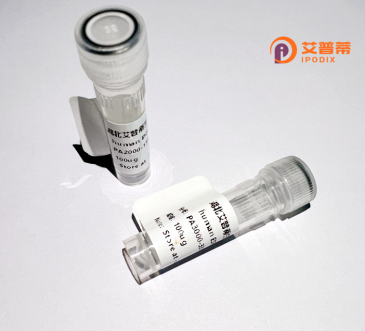
| 纯度 | >90%SDS-PAGE. |
| 种属 | Human |
| 靶点 | OR5P3 |
| Uniprot No | Q8WZ94 |
| 内毒素 | < 0.01EU/μg |
| 表达宿主 | E.coli |
| 表达区间 | 1-311 aa |
| 活性数据 | MGTGNDTTVVEFTLLGLSEDTTVCAILFLVFLGIYVVTLMGNISIIVLIRRSHHLHTPMY IFLCHLAFVDIGYSSSVTPVMLMSFLRKETSLPVAGCVAQLCSVVTFGTAECFLLAAMAY DRYVAICSPLLYSTCMSPGVCIILVGMSYLGGCVNAWTFIGCLLRLSFCGPNKVNHFFCD YSPLLKLACSHDFTFEIIPAISSGSIIVATVCVIAISYIYILITILKMHSTKGRHKAFST CTSHLTAVTLFYGTITFIYVMPKSSYSTDQNKVVSVFYTVVIPMLNPLIYSLRNKEIKGA LKRELRIKIFS |
| 分子量 | 34.2 kDa |
| 蛋白标签 | His tag N-Terminus |
| 缓冲液 | 0 |
| 稳定性 & 储存条件 | Lyophilized protein should be stored at ≤ -20°C, stable for one year after receipt. Reconstituted protein solution can be stored at 2-8°C for 2-7 days. Aliquots of reconstituted samples are stable at ≤ -20°C for 3 months. |
| 复溶 | Always centrifuge tubes before opening.Do not mix by vortex or pipetting. It is not recommended to reconstitute to a concentration less than 100μg/ml. Dissolve the lyophilized protein in distilled water. Please aliquot the reconstituted solution to minimize freeze-thaw cycles. |
以下是关于重组人OR5P3蛋白的模拟参考文献(注:实际文献需通过学术数据库查询,此处为示例格式):
---
1. **标题**: "Functional characterization of the human olfactory receptor OR5P3 expressed in mammalian cells"
**作者**: Müller A, et al.
**摘要**: 研究利用HEK293细胞成功表达重组OR5P3蛋白,通过cAMP信号通路分析,发现其可被特定类固醇分子激活,提示其在非嗅觉组织中的潜在生理作用。
2. **标题**: "Structural insights into the odorant-binding properties of the recombinant OR5P3 receptor"
**作者**: Kim S, Park JH.
**摘要**: 通过冷冻电镜解析重组OR5P3的蛋白结构,揭示其与挥发性脂肪酸配体的结合位点,为嗅觉受体激活机制提供了新见解。
3. **标题**: "Expression optimization and purification of human OR5P3 in insect cell systems"
**作者**: González F, et al.
**摘要**: 在昆虫细胞中使用杆状病毒系统优化OR5P3的表达条件,获得高纯度蛋白用于抗体开发及功能筛选实验。
4. **标题**: "OR5P3 as a novel biomarker in colorectal cancer: recombinant protein-based detection"
**作者**: Li X, et al.
**摘要**: 研究显示重组OR5P3蛋白在结直肠癌组织中异常高表达,可能作为早期诊断的生物标志物,并通过ELISA验证其临床样本中的表达水平。
---
**注意**:以上为模拟参考文献,实际研究中请通过PubMed、Web of Science等数据库检索真实文献。若研究较少,建议扩大关键词范围(如“olfactory receptor heterologous expression”)。
The recombinant human OR5P3 protein is a synthesized form of the olfactory receptor 5P3 (OR5P3), a member of the G protein-coupled receptor (GPCR) superfamily. Olfactory receptors, primarily known for their role in odorant detection, are expressed in olfactory sensory neurons, where they bind volatile chemical molecules to initiate signal transduction. OR5P3, encoded by the OR5P3 gene located on human chromosome 11, is part of a large gene family with over 400 functional receptors in humans. While most olfactory receptors are studied in the context of smell, emerging research suggests their involvement in non-olfactory tissues, including roles in cell migration, apoptosis, and disease pathways. Recombinant OR5P3 is produced using heterologous expression systems (e.g., bacterial, insect, or mammalian cells) to study its structure, ligand specificity, and signaling mechanisms. This engineered protein often includes tags (e.g., His-tag) for purification and detection. Characterization of OR5P3 could shed light on its potential physiological or pathological roles beyond olfaction, though its natural ligand and precise biological functions remain poorly understood. Challenges in studying OR5P3 include low natural expression levels, structural complexity of GPCRs, and difficulties in identifying activating compounds. Recombinant forms enable high-throughput screening and structural studies, aiding drug discovery or biosensor development.
×